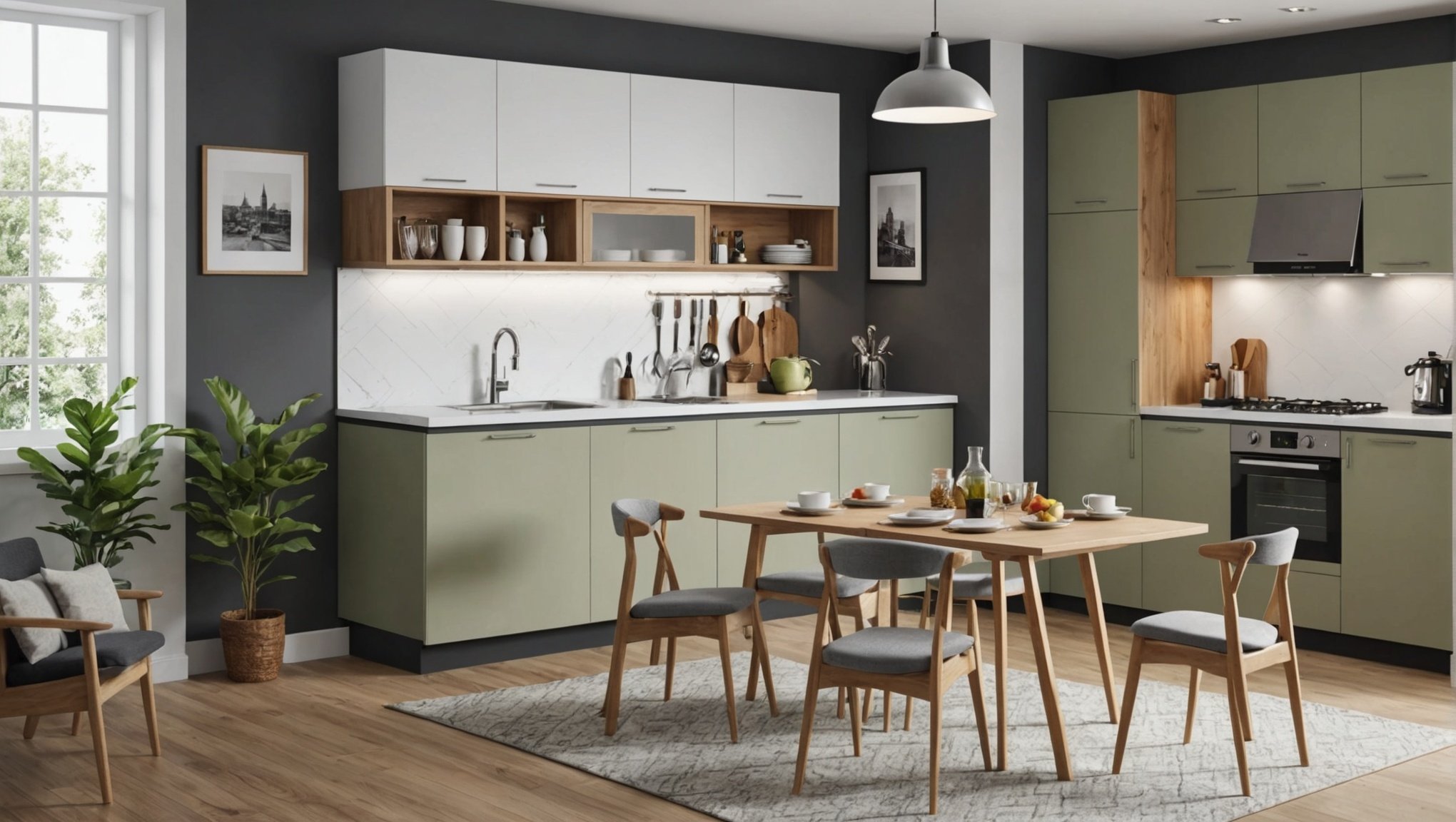Tiny kitchens can feel cramped, but they don’t have to sacrifice functionality. A foldable dining area offers a perfect solution to maximize your space while maintaining style. From wall-mounted tables to cleverly designed furniture, innovative tips can transform your kitchen into a multifunctional hub. Discover how to create a cozy dining nook that complements your lifestyle, enhances your home, and makes every meal enjoyable—no matter how limited your square footage.
Understanding the Need for Foldable Dining Areas
In today’s compact living spaces, a foldable dining area offers a practical solution for those grappling with limited room. As urban dwellings shrink, the demand for space-saving furniture has surged, particularly in the realm of small kitchen solutions. But why are these foldable options so appealing?
Also to read : Selecting the Perfect Kitchen Sink Size to Meet Your Family”s Needs
Firstly, a foldable dining area maximises available space by offering flexibility. When not in use, the furniture can be neatly tucked away, freeing up the kitchen for other activities. This adaptability is crucial in tiny kitchens, where every square inch counts.
Moreover, foldable furniture doesn’t just serve a functional purpose; it also enhances the aesthetics of a home. Modern designs ensure that these pieces are not only practical but also stylish, seamlessly blending into contemporary interiors. This dual benefit of functionality and visual appeal makes foldable dining areas a popular choice.
In parallel : Selecting the Perfect Kitchen Extractor Fan: A Guide for Optimal Fit and Functionality Based on Your Space
However, the allure of foldable furniture isn’t without its challenges. Small kitchens often suffer from limited storage, making it difficult to accommodate even compact furniture. Additionally, ensuring that the foldable mechanisms are durable and easy to operate is vital to maintaining their long-term usability. Despite these hurdles, the advantages of foldable dining solutions make them an invaluable addition to any compact kitchen.
Design Inspirations for Foldable Dining Areas
Exploring various kitchen design ideas can transform your space, especially when integrating foldable furniture design. These designs not only save space but also add a touch of style to your home.
Contemporary Styles
Modern space-efficient dining solutions often embrace sleek lines and innovative materials. Think of tables that fold into walls or chairs that stack seamlessly. Contemporary designs focus on functionality without sacrificing aesthetics, often featuring materials like glass and metal to enhance the modern look.
Rustic Inspirations
For those who adore a cosy, warm atmosphere, rustic kitchen design ideas can be an excellent choice. Incorporating natural wood finishes and vintage accents, these designs offer charming and timeless appeal. Foldable tables with distressed wood surfaces or benches that tuck under tables can add character while being practical.
Minimalist Approaches
Minimalism champions simplicity and efficiency, making it ideal for space-efficient dining. The minimalist approach to foldable furniture design often involves clean lines and neutral colours, providing an uncluttered look. Visual examples include wall-mounted drop-leaf tables or folding chairs that disappear into cabinets, ensuring a seamless blend with the kitchen’s overall aesthetic.
By exploring these styles, you can find a design that perfectly fits your kitchen’s needs while enhancing its visual appeal.
Types of Foldable Furniture for Dining Areas
In the quest for space-saving options, foldable furniture plays a pivotal role in enhancing functionality without compromising style. A variety of foldable tables cater to different needs and aesthetics, offering solutions for compact living spaces.
Overview of Foldable Table Designs
Foldable tables come in diverse designs, each tailored to specific space constraints and stylistic preferences. Wall-mounted drop-leaf tables are a popular choice, ideal for kitchens where floor space is at a premium. These tables fold flat against the wall when not in use, providing ample room for movement.
Comparison of Materials and Durability
The durability of foldable tables largely depends on the materials used. Multipurpose furniture crafted from solid wood offers longevity and a classic look, while metal and glass options provide a sleek, modern aesthetic. However, metal frames are often more robust, ensuring the mechanisms withstand frequent use.
Recommendations for Multifunctional Chairs
When selecting chairs, consider options that complement your foldable table. Stackable or foldable chairs are excellent space-saving options, easily stored away when not needed. Some designs even offer additional functionality, such as integrated storage or adjustable heights, enhancing their usefulness in small dining areas.
Practical Tips for Incorporating a Foldable Dining Area
To achieve space optimization with a foldable dining area, begin by measuring and planning your space effectively. Assess your kitchen layout to identify potential locations where foldable furniture can be integrated without obstructing movement. Consider areas near windows or walls where light and space can be maximized.
Choose the right location by evaluating accessibility and convenience. A foldable table near the kitchen counter can serve dual purposes, such as additional prep space or a quick dining spot. Ensure that the area allows for easy folding and unfolding of the furniture, avoiding tight corners or high-traffic zones.
For creative storage solutions, think vertically. Wall-mounted racks or hooks can store foldable chairs, keeping them out of the way when not in use. Additionally, consider under-table storage options for smaller items, ensuring that every inch of space is utilized efficiently.
When selecting foldable furniture, prioritise pieces that offer multifunctionality. Look for tables with built-in shelves or chairs with integrated storage compartments. These features enhance practicality, making your kitchen more organised and functional. By carefully planning and choosing the right elements, your foldable dining area will seamlessly blend into your kitchen, enhancing both style and utility.
Visual Aids and Diagrams
Incorporating visual aids like kitchen layout diagrams is essential when planning a foldable dining area. These tools allow you to see how furniture will fit into your space, ensuring optimal space planning.
Importance of Visual Aids
Visual aids provide a clear representation of the available space, helping you avoid common pitfalls in furniture arrangement. By visualising your kitchen layout, you can identify the best spots for foldable furniture, ensuring both functionality and aesthetics are maintained.
Examples of Layout Diagrams
Consider using layout diagrams to explore different configurations. For small kitchens, diagrams that illustrate wall-mounted tables or compact seating arrangements can be particularly helpful. These diagrams offer a bird’s-eye view, allowing you to experiment with various setups before making any physical changes.
Tips for Using Design Software or Apps
Design software or apps can enhance your design visualization process. Tools like SketchUp or RoomSketcher enable you to create detailed 3D models of your kitchen, incorporating foldable furniture elements. These apps often feature drag-and-drop functionality, making it easy to adjust your plans as needed. By leveraging technology, you can ensure your foldable dining area is both stylish and space-efficient.
Case Studies and Testimonials
Exploring real-life examples of homeowners who have successfully integrated foldable dining areas can provide valuable insights. These user experiences highlight both the challenges and triumphs faced during the implementation process, offering a practical perspective on the benefits of these solutions.
One homeowner, Sarah, transformed her tiny apartment kitchen with a wall-mounted drop-leaf table. Her testimonial emphasized the newfound functionality and style that the table brought to her space. The table not only provided a convenient dining area but also served as additional counter space when needed. Sarah’s experience underscores the importance of choosing versatile furniture that complements the existing decor.
Another success story comes from Mark, who opted for foldable chairs with integrated storage. His feedback focused on the ease of use and the significant space savings achieved. Mark appreciated how these chairs could be neatly stored away, freeing up room for other activities.
Lessons learned from these foldable dining success stories include the importance of careful planning and the selection of high-quality, durable materials. Homeowners also noted the necessity of considering the ease of operation for foldable mechanisms to ensure long-term satisfaction. These testimonials illustrate the transformative impact of foldable dining solutions.
Conclusion: Achieving Aesthetic and Functional Balance
Incorporating a foldable dining area into your home requires careful consideration of both functional design and aesthetic appeal. The key is to find a balance that enhances your living space while maintaining practicality.
When planning your dining area, focus on small space solutions that cater to your specific needs. This involves selecting furniture that not only fits the physical constraints of your kitchen but also complements its overall style. Functional design should prioritise ease of use and durability, ensuring that foldable mechanisms operate smoothly and withstand frequent use.
Moreover, don’t shy away from exploring innovative designs that push the boundaries of conventional solutions. This could mean experimenting with different materials, colours, or configurations to create a space that is uniquely yours.
Remember, the goal is to achieve a harmonious blend of aesthetics and functionality. By considering these elements thoughtfully, you can transform even the smallest kitchen into a stylish and efficient area that meets your dining needs. Embrace the challenge of small space living by finding creative ways to make the most of every inch, ensuring your home is both beautiful and practical.






